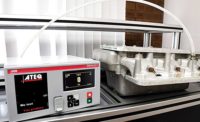Unmanned air vehicles represent the most dynamic growth sector of the aerospace industry. In fact, UAV spending will more than double over the next decade, from $4.9 billion to $11.5 billion annually. ASSEMBLY recently asked two UAV production managers to discuss the challenges they’re faced with on the plant floor.
As unmanned air vehicles (UAVs) become more important to the military, production volumes have been growing annually. According to the Teal Group, UAVs represent the most dynamic growth sector of the aerospace industry. In fact, UAV spending will more than double over the next decade, from $4.9 billion to $11.5 billion annually.
ASSEMBLY recently asked two UAV production managers to discuss the challenges they’re faced with on the plant floor.Don Gawis director of unmanned military system production at Northrop Grumman Aerospace Systems. His company builds reconnaissance UAVs such as theFire Scouthelicopter and theGlobal Hawkfixed-wing aircraft, which are used by the U.S. Navy and the U.S. Air Force.Jim Glowackiis director of manufacturing at AAI Corp., an operating unit of Textron Systems. His assembly line produces tactical aircraft such as theRQ-7B Shadow, which is used by the U.S. Army and the U.S. Marine Corps.
ASSEMBLY:How is UAV assembly different than traditional manned aircraft production?
Gaw:UAV assembly can, in some instances, be very similar to manned aircraft. Platforms that are expected to serve the commercial, military or foreign services doing their jobs for many years over all parts of the globe are built very similar to manned aircraft constructed of the same materials. However, platforms built for rapid development purposes or drone-type applications are not necessarily designed for longevity or flying in public airspace.
Glowacki:The major difference is the shear size comparison, which also drives facility needs and capital and tooling needs, as well. But, other major factors include components that make the aircraft unmanned, as well as the all-important payload that currently provides high-resolution video. Another major aspect that separates manned from unmanned aircraft is the modular nature of the unmanned aircraft. Outside of shear scale of the units, the manufacturing processes are very similar to include procedural compliance such as FOD and Tool Control. Construction materials; however, have some similarities, but also some differences due mostly to the cost considerations and environments in which the products are flown.
ASSEMBLY:How are UAVs typically assembled?
Gaw:This depends on the expectation of the UAV. Rapid prototyping and proof of concept vehicles can be built similar to model airplanes or even surfboards. Balsa stick construction could be the choice for a smaller UAV or limited use foam tools for layups may be adequate for medium- and large-sized vehicles. Again, platforms that are designed for commercial, military or foreign services are built with tools similar to their manned counterparts utilizing many of the lean and 5S lessons learned over the years.
Glowacki:UAVs are assembled and integrated on a dedicated pull production line, but the sub-level items come from dedicated cells, such as electrical assembly, mechanical assembly, and composites and bonding. Within the cells are fixed stations for tooling in which the operators move to the workstations when the demand exists for the supply item.
ASSEMBLY:How complex is the UAV assembly process?
Gaw:Depending on the platform, UAVs can be as simple as a high-performance model airplane or as complex as a modern manned aircraft. Additionally, the different types of components are dependent on the size and mission performed by the UAV. In most cases, the larger the UAV, the more capable and versatile its payload and the more involved the assembly process.
Glowacki:There are approximately seven major process groupings consisting of composites, bonding, electrical assembly, mechanical assembly, integration, static UAV test and flight testing. Surrounding these process groupings are a number of certification processes that provide a high level of quality and ensure conformance to all contractual requirements. The major components are fuselage, outer wings, center wing, tail section, tail booms, payload, engine, landing system, batteries, landing equipment and electrical communications equipment.
ASSEMBLY:What’s being done to improve manufacturing efficiency on the plant floor?
Gaw:Northrop Grumman incorporates lean manufacturing, 5S, line balancing and just-in-time in many UAV assembly lines. State-of-the-art production tools and methods are incorporated in new lines for commonality and efficiency. However, for the older lines, new tools are not always the right choice and good improvements have been realized utilizing lean and 5S.
Glowacki:The major focus is on reduction of product lead times, improving product flow and cost reduction. Lean Six Sigma is the driving force behind these improvements. It all begins with the workforce and the culture. That’s why we have invested a great deal of money, time and energy in making sure the workforce understands how to recognize waste and to use continuous improvement tools to eliminate the waste. Additionally, as the product grows and matures to increase its system capability, we also improve the design from a DFX standpoint, as well as improve the tooling to embed more poka-yoke in the build process rending an increase in process repeatability.
ASSEMBLY:What are some of the joining challenges that composite materials present?
Gaw:Currently and for the foreseeable future, composites, metals and fabric are used where it has proven to be a reliable material in past applications. We are using much of the same technology as our current manned vehicles for attaching components. These range from standard rivets and standard layups to combinations of mechanical and adhesive bonding.
Glowacki:The joining challenges have decreased significantly over the years, due to the advanced growth in technology in bonding lightweight materials. The focus is always on finding the right adhesive bonding materials that provide the correct adhesion to the numerous substrates, and meet the temperature, strength and flexibility requirements for the system design. Additional considerations are cost, ease of use and tolerance to process variation. Maintaining an adequate bond line, as well as cleanliness requirements, can be costly and time consuming.
UAVs Present Numerous Assembly Challenges
Looking for a reprint of this article?
From high-res PDFs to custom plaques, order your copy today!







